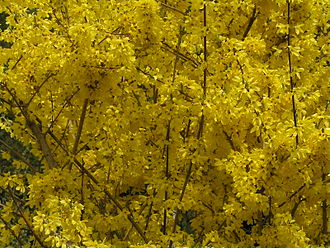This spring, for our “nature walks” (read: nature drives, preggers…wait, read: pointing out nature periodically when we’re driving somewhere else), we are tracking the blooms of the season. Here is the order of appearance.
Week One
1. Daffodils (pictured above)
2. Japanese Quince. My MIL calls them her “sticks”. This is the one time of year the clump of sticks does something fun. 3. Bradford Pears. These trees are everywhere in my area. They are really pretty in early spring, but they usually only make it ten years or so before the next windstorm cracks them in half.
3. Bradford Pears. These trees are everywhere in my area. They are really pretty in early spring, but they usually only make it ten years or so before the next windstorm cracks them in half. 4. Forsythia. Lots of the olden-day gardening manuals talked about planting this or that so many weeks “after the forsythia bloom”.
4. Forsythia. Lots of the olden-day gardening manuals talked about planting this or that so many weeks “after the forsythia bloom”. 
Week Two
 This week, we found that the Chinese Magnolias (above) were blooming. Also blooming, if their owners didn’t trim back past the year old wood is the Chinese Privet (below).
This week, we found that the Chinese Magnolias (above) were blooming. Also blooming, if their owners didn’t trim back past the year old wood is the Chinese Privet (below).
 Finally, we saw that the Easter Redbuds bloom.
Finally, we saw that the Easter Redbuds bloom.

Weeks 3-4
 1. Dandelion
1. Dandelion
 3. Chickweed
3. Chickweed
Week Five
 1. Wisteria: (above) Here, this plant seems to creep all over everything, like a really pretty kudzu.
1. Wisteria: (above) Here, this plant seems to creep all over everything, like a really pretty kudzu.
 2. Fleabane: I spent the morning trying to name this roadside daisy-looking plant.
2. Fleabane: I spent the morning trying to name this roadside daisy-looking plant.
 3. Iris: (Our state flower)
3. Iris: (Our state flower)
 4. Azaleas: Azaleas are EVERYWHERE right now.
4. Azaleas: Azaleas are EVERYWHERE right now.
 5. Buttercups: These cute little weedy wildflowers are up in our yard.
5. Buttercups: These cute little weedy wildflowers are up in our yard.
 6. Common Blue Violet: These are considered weeds, but we really like them.
6. Common Blue Violet: These are considered weeds, but we really like them.
After that, it was just bloom-o-rama around town. Too many to count!



As a beekeeper, I love your post! I want to make a log like this for two reasons: To know what is available for my bees at a given time of year, and also to observe what/if those patterns change from year to year or over the longer range. Thanks for posting this! What is your agricultural zone?
an oldie, but very handy list. with notes on how to adapt to your climate zone — http://arnoldia.arboretum.harvard.edu/pdf/articles/1939-7–the-order-of-bloom-of-trees-and-shrubs-at-the-arnold-arboretum.pdf